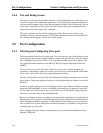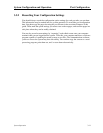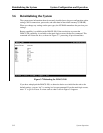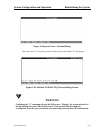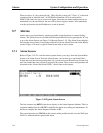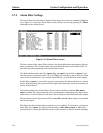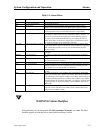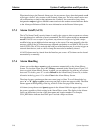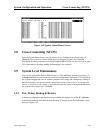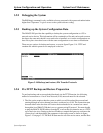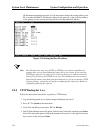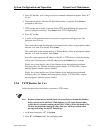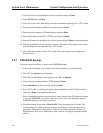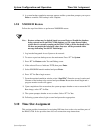
3-18 System Operation
Model No.
Running Head
Alarms System Configuration and Operation
When interfacing to the External Alarm ports, the occurrence of any alarm designated as crit
will trigger a form-C relay contact on the External Alarm port. The relay contact action sets
off an annunciator or lamp at the equipment site. Similarly, the occurrence of any alarm
designated as major triggers a different contact and activates another external indicator. Refer
to the Alarm port Reference Guide for more information on the External Alarm ports.
3.7.3 Alarm Cutoff (ACO)
The ACO (Alarm Cutoff) security feature is used by the system to alert an operator to alarms
that clear themselves while the system is unattended. The ACO option settings are aco-on and
aco-off. If ACO is set to report or log alarms, any alarm set to report or log with a major
modifier brings up an additional alarm message on the screen. You must manually clear this
message, which is the ACO alarm message (depends on whether or not IMACS-200 is set for
latch or CUR). The ACO is used with the node port of the Interface port. It can also trigger an
external alarm device, such as a bell or lamp, that must also be manually cleared.
All ACO alarms must be cleared from the Interface port screen. ACO alarms can be cleared
automatically or manually.
3.7.4 Alarm Handling
Alarms set to either log or report record occurrences automatically to the Alarm History
Screen. To view that screen, press “h” (History command) in the Alarm Screen. Figure 3-12
shows a typical Alarm History Screen, in which you can update the log with any new alarms
that occur. To do this, press “r” to select Refresh in the Alarm History Screen. Or, to delete
all entries in the log, press “c” to select Clear in the Alarm History Screen.
The alarm log may contain more than one screen (page) of data. To scroll through the log,
press “u” or “d” (pgUp or pgDn) to move up one page or down one page at a time. The latest
alarms appear at the beginning of the log, which is on the first page of the alarm log.
All alarms (except those set to ignore) appear in the Alarms field in the upper right corner of
the screen, regardless of their setting in the Alarm Filters screen. The display in the Alarms
field is an abbreviated version of the alarm name and location number. For example,
CGA_RED below indicates that WAN port 2 has had a Major red alarm.



